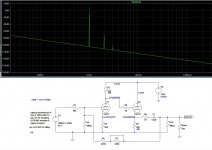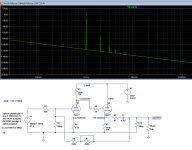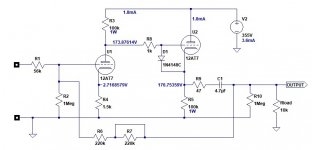I found and resurrected an old Concordant pre I cloned about 30 years ago. But I have loads of 12AT7s, but only two mismatched 12AX7s. And less gain would be nice too, but my question is, can I simply sub the 12AT7s in place of the 12AX7s without causing damage? I realise I will eventually have to recalculate the resistor values for the 12AT7s, and change the output caps to keep the bass response, but would there be any initial risk in swapping them?
An externally hosted image should be here but it was not working when we last tested it.
A 300k ohm plate load on a 12AT7 would probably result in that type of tube being run very cold-biased, too close to cutoff all the time. It would probably make sound, but it would not be an improvement. It's a simple enough circuit to re-design to fit 12AT7/ECC81, though, if that's what you want to do.
would there be any initial risk in swapping them?[/IMG]
Probably no risk, but check the DC voltage at the input plate to see if it's at
a reasonable point. The plate resistor is rather high in value for a 12AT7.
You'll have to recalculate all the resistors.
Last edited:
Thanks for the replies.
Rongon and rayma; I'll recalculate (if I can) the anode resistor to compensate. When I cloned this I knew even less than I do now, if that's possible!
The circuit as it stands has the volume pot after the line stage, which is fine for noise reduction, but not output impedance, so I'll probably try it before the line stage later on. Thus resurrection has cost me nothing so far; I had to build a psu for it, but I had everything already, so not buying more valves appeals to me.
Rongon and rayma; I'll recalculate (if I can) the anode resistor to compensate. When I cloned this I knew even less than I do now, if that's possible!
The circuit as it stands has the volume pot after the line stage, which is fine for noise reduction, but not output impedance, so I'll probably try it before the line stage later on. Thus resurrection has cost me nothing so far; I had to build a psu for it, but I had everything already, so not buying more valves appeals to me.
Surprisingly little change in net gain will be observed, after things are squared away. Remember, the gain of a common cathode triode is function of both μ and RP. The 12AT7's lower μ is compensated for by its much lower RP.
I suggest the substitution not be made. The 'X7 triode is more linear than the 'T7 triode. Nice current production 'X7s are not especially expensive. For instance, Jim McShane charges $33.50 for a matched pair of "reissue" TungSol.
I suggest the substitution not be made. The 'X7 triode is more linear than the 'T7 triode. Nice current production 'X7s are not especially expensive. For instance, Jim McShane charges $33.50 for a matched pair of "reissue" TungSol.
Thanks Eli, I guess I'm just mean! But I've created a loft (workshop) system for about £45. Free Heybrook HB3s, just £22 to refoam, less than £20 to recap the power amp, and £5 for a DVD player. So not spending appealed to me. But I guess I may have to go mad!
And Ketje, now you're spoiling all the fun! But thanks for pointing that out.
But thanks for pointing that out.
And Ketje, now you're spoiling all the fun!
Last edited:
Thanks Eli, I guess I'm just mean!
I too am cheap.
I'll recalculate (if I can) the anode resistor to compensate.
Probably all the resistors will have to change. Remember that it's a direct-coupled circuit.
It's not so difficult, replace the 300k by 150k for a ECC81 and you will end-up with allmost the same voltages.Total current by the circuit goes up allmost 1mA.Probably all the resistors will have to change. Remember that it's a direct-coupled circuit.
Ketje
A little more fun with it...
If you change R3 and R5 from 56k to 100k, and R4 to 1.5k, the two 12AT7 triode will bias at about 1.8mA plate current each. Your power supply would need to supply 3.6mA total plate current for a stereo pair.
The gain remains the same. Interesting that the modeled distortion spectrum changes quite a bit, with 3rd and higher harmonics more pronounced. 12AT7 usually works better with 3mA plate current (all other things being equal).
If you change R3 and R5 from 56k to 100k, and R4 to 1.5k, the two 12AT7 triode will bias at about 1.8mA plate current each. Your power supply would need to supply 3.6mA total plate current for a stereo pair.
The gain remains the same. Interesting that the modeled distortion spectrum changes quite a bit, with 3rd and higher harmonics more pronounced. 12AT7 usually works better with 3mA plate current (all other things being equal).
Attachments
Include a diode from the 1st plate to the second cathode. It will protect the tube while the heater is cold.
Absolutely!
And don't forget to raise the heater supply up to about +85V, to relieve cathode-heater stress on the second stage, at least as much as is possible with a +355V B+.
Attachments
Last edited:
Wow, thanks for all the advice! I should mention that the trafo I have (275-0-275 unloaded) sags a bit under the current load. I will have to open it all up and measure the actual voltages, as I can't remember the details. Replacing it would cost more than I wish to spend, more than a couple of 12AX7s.
Rongon: Increasing higher order harmonics is something I would like to avoid.
Stocktrader 200: The output of the line stage is into the 50k volume pot. Something I would also like to change; putting it in front would reduce the output impedance, no? But reducing noise attenuation at lower volume settings, as I understand it. Doug Dunlop seemed to make these things with whatever he had in his parts bin at the time; the phono stage in this version uses ECC85/6AQ8s (I have one of each in it!), but the Excelsior (a later version) uses 12AX7s! I have the circuit for that, and it runs 315V HT (loaded).
I used to clone these things (Paragon, Croft Micro, Concordant, Velleman K4000 power amp) by simply measuring voltages and drawing out then etching the pcbs. Amazingly they all worked, and I still have the big Velleman and this pre. I guess I didn't know any better.
Rongon: Increasing higher order harmonics is something I would like to avoid.
Stocktrader 200: The output of the line stage is into the 50k volume pot. Something I would also like to change; putting it in front would reduce the output impedance, no? But reducing noise attenuation at lower volume settings, as I understand it. Doug Dunlop seemed to make these things with whatever he had in his parts bin at the time; the phono stage in this version uses ECC85/6AQ8s (I have one of each in it!), but the Excelsior (a later version) uses 12AX7s! I have the circuit for that, and it runs 315V HT (loaded).
I used to clone these things (Paragon, Croft Micro, Concordant, Velleman K4000 power amp) by simply measuring voltages and drawing out then etching the pcbs. Amazingly they all worked, and I still have the big Velleman and this pre. I guess I didn't know any better.
A bit more info. Sorry about that.
Line and phono stages.
Controls and socketry wiring.
Excelsior circuit, taken from a friend's unit. Note; all ECC83s and 315V HT supply loaded.
This is what I was thinking of implementing, but haven't done anything about it yet. First I just wanted to get the thing running. Which it is, but I haven't put it into the main system to hear how it really performs.
EDIT: I've just been trying to follow the LTSpice tutorial on this forum. Unfortunately I can't make head or tail of it, I just got a headache!
Line and phono stages.
An externally hosted image should be here but it was not working when we last tested it.
Controls and socketry wiring.
An externally hosted image should be here but it was not working when we last tested it.
Excelsior circuit, taken from a friend's unit. Note; all ECC83s and 315V HT supply loaded.
An externally hosted image should be here but it was not working when we last tested it.
This is what I was thinking of implementing, but haven't done anything about it yet. First I just wanted to get the thing running. Which it is, but I haven't put it into the main system to hear how it really performs.
EDIT: I've just been trying to follow the LTSpice tutorial on this forum. Unfortunately I can't make head or tail of it, I just got a headache!
Last edited:
I have never got on very well with 12ax7's.
Always ended up using a different model like the 12au7.
It seemed to be more stable and less noisy.
I have used 2 12ax7's halves in series and the tube just fed back on itself.
When I look around there seems to be plenty of amps with the halves in parallel, maybe they found the same problem ?
Having said that 2 12ax7 halves in series is around 10,000 gain so not surprising it was unstable !
Always ended up using a different model like the 12au7.
It seemed to be more stable and less noisy.
I have used 2 12ax7's halves in series and the tube just fed back on itself.
When I look around there seems to be plenty of amps with the halves in parallel, maybe they found the same problem ?
Having said that 2 12ax7 halves in series is around 10,000 gain so not surprising it was unstable !
- Status
- This old topic is closed. If you want to reopen this topic, contact a moderator using the "Report Post" button.
- Home
- Amplifiers
- Tubes / Valves
- 12AT7 for 12AX7 in preamp


